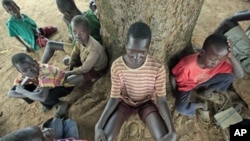The World Health Organization (WHO) is planning an international scientific conference on the causes and treatment of nodding disease – an illness that continues to ravage some parts of Africa.
The meeting will be held in July and August and will be attended by medical experts from around the world, according to Dr. Charles Okot, the organization’s country advisor in Uganda on disease prevention and control.
The mystery disease affects only children. It gradually devastates its victims through debilitating seizures, stunted growth, wasted limbs, mental disabilities and sometimes starvation.
“It is a serious problem,” said Dr. Okot, “we are talking of over 3,000 people suspected of having nodding syndrome and about 170 presumed to have died from the disease.”
He said the causes of the illness are not known, although a number of studies have been conducted. “These studies have not revealed anything tangible as to the cause of the disease.”
Dr Okot believes there may be a link between nodding disease and (Onchocercias) river blindness, a parasitic infection. “All the counties that are reporting nodding syndrome are also reporting a high prevalence of river blindness. The partial, geographical association is very strong.”
However, he added, scientific proof of a link between Onchocercias and nodding disease is “an area for further research.”
The treatment is basically anti-epileptic, he said, because the manifestation of nodding disease is quite similar to epilepsy.
Dr Okot said WHO, working with Uganda’s ministry of health, has established a coordination structure for all forms of intervention.
In addition, he said, screening and treatment centers have been established in the three most affected districts – Kitgum, Lamwo and Padyer.
WHO and Uganda’s ministry of health has also provided trained health workers in the affected districts with medical supplies.
Dr Okot emphasized the need for further research to determine the cause and progression of the disease, and its social and economic impact. “Various parts of this research are actually on-going.”
The WHO will sponsor an international scientific conference bringing together all scientists who have done studies on nodding syndrome, Dr Okot said.
The disease, he said, has also been reported in Sothern Sudan, Tanzania and Liberia.
The meeting will be held in July and August and will be attended by medical experts from around the world, according to Dr. Charles Okot, the organization’s country advisor in Uganda on disease prevention and control.
The mystery disease affects only children. It gradually devastates its victims through debilitating seizures, stunted growth, wasted limbs, mental disabilities and sometimes starvation.
“It is a serious problem,” said Dr. Okot, “we are talking of over 3,000 people suspected of having nodding syndrome and about 170 presumed to have died from the disease.”
He said the causes of the illness are not known, although a number of studies have been conducted. “These studies have not revealed anything tangible as to the cause of the disease.”
Dr Okot believes there may be a link between nodding disease and (Onchocercias) river blindness, a parasitic infection. “All the counties that are reporting nodding syndrome are also reporting a high prevalence of river blindness. The partial, geographical association is very strong.”
However, he added, scientific proof of a link between Onchocercias and nodding disease is “an area for further research.”
The treatment is basically anti-epileptic, he said, because the manifestation of nodding disease is quite similar to epilepsy.
Dr Okot said WHO, working with Uganda’s ministry of health, has established a coordination structure for all forms of intervention.
In addition, he said, screening and treatment centers have been established in the three most affected districts – Kitgum, Lamwo and Padyer.
WHO and Uganda’s ministry of health has also provided trained health workers in the affected districts with medical supplies.
Dr Okot emphasized the need for further research to determine the cause and progression of the disease, and its social and economic impact. “Various parts of this research are actually on-going.”
The WHO will sponsor an international scientific conference bringing together all scientists who have done studies on nodding syndrome, Dr Okot said.
The disease, he said, has also been reported in Sothern Sudan, Tanzania and Liberia.









